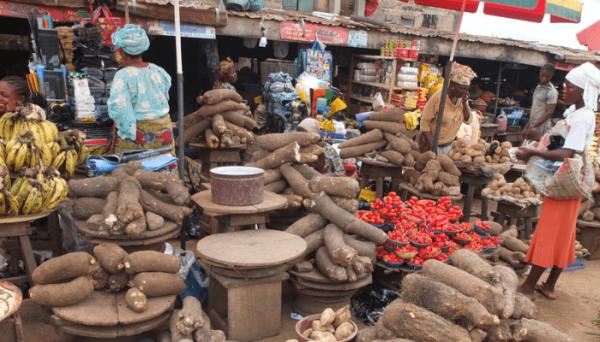
The headline inflation for June 2025 moderated to 22.22 per cent relative to the May 2025 headline inflation rate of 22.97 per cent.
This was disclosed by the National Bureau of Statistics on Wednesday.
According to the latest Consumer Price Index report released by the Bureau, the year-on-year figure reflects a 0.75 percentage point decline from the previous month and a significant 11.97 percentage point drop when compared to June 2024, which recorded an inflation rate of 34.19 per cent.
The decline in annual inflation is being recorded against the backdrop of a rebased index, with 2024 as the new base year.
On a month-on-month basis, however, inflation rose slightly to 1.68 per cent in June, compared to 1.53 per cent in May, suggesting that while the pace of price increases is slowing on an annual basis, prices are still rising faster from one month to the next.
The CPI rose from 121.4 in May to 123.4 in June, indicating persistent price pressures, especially in food, transport, and housing.
The NBS report read, “The Consumer Price Index rose to 123.4 in June 2025, reflecting a 2.0-point increase from the preceding month (121.4). In June 2025, the Headline inflation rate eased to 22.22 per cent relative to the May 2025 headline inflation rate of 22.97 per cent. Looking at the movement, the June 2025 Headline inflation rate showed a decrease of 0.75 per cent compared to the May 2025 Headline inflation rate.
“On a year-on-year basis, the Headline inflation rate was 11.97 per cent lower than the rate recorded in June 2024 (34.19 per cent). This shows that the Headline inflation rate (year-on-year basis) decreased in June 2025 compared to the same month in the preceding year (i.e., June 2024), though with a different base year, November 2009 = 100.”
The food inflation rate stood at 21.97 per cent year-on-year in June, a sharp drop from 40.87 per cent recorded in June 2024.
This significant fall is attributed largely to the base year effect. On a month-on-month basis, food inflation rose to 3.25 per cent in June, up from 2.19 per cent in May, driven by price increases in staples such as tomatoes, pepper, dried green peas, crayfish, shrimps, meat, plantain flour, and ground pepper.
The average annual rate of food inflation for the twelve-month period ending June 2025 stood at 28.28 per cent, down by 7.02 percentage points from the 35.3 per cent recorded over a similar period last year.
Core inflation, which excludes volatile items such as agricultural produce and energy, declined year-on-year to 22.76 per cent in June 2025 from 27.4 per cent in June 2024.
On a month-on-month basis, however, core inflation increased to 2.46 per cent, up from 1.10 per cent in May, reflecting renewed pressures in non-food components.
The average twelve-month inflation rate for core items stood at 24.14 per cent in June 2025, slightly higher than the 24.01 per cent recorded in the corresponding period of 2024.
The report showed a divergence in inflation trends between urban and rural areas.
Urban inflation dropped to 22.72 per cent year-on-year in June from 36.55 per cent in June 2024, while rising to 2.11 per cent month-on-month, from 1.40 per cent in May.
The twelve-month average for urban inflation also declined to 28.16 per cent.
Rural inflation followed a similar pattern, easing to 20.85 per cent year-on-year from 32.09 per cent, but slowing month-on-month to 0.63 per cent in June, from 1.83 per cent in May. The average annual rural inflation rate stood at 24.65 per cent.
In terms of state-level data, Borno recorded the highest year-on-year all-items inflation rate at 31.63 per cent, followed by Abuja at 26.79 per cent and Benue at 25.91 per cent.
The slowest increases were recorded in Zamfara at 9.90 per cent, Yobe at 13.51 per cent, and Sokoto at 15.78 per cent.
On a month-on-month basis, the sharpest increases were in Ekiti at 5.39 per cent, Delta at 5.15 per cent, and Lagos at 5.13 per cent, while Zamfara, Niger, and Plateau recorded declines of 6.89, 5.35, and 4.01 per cent, respectively.
Food inflation was most severe in Borno at 47.40 per cent year-on-year, followed by Ebonyi at 30.62 per cent and Bayelsa at 28.64 per cent.
Katsina, Adamawa, and Sokoto recorded the slowest food inflation at 6.21, 10.90, and 15.25 per cent, respectively.
On a month-on-month basis, food inflation rose fastest in Enugu at 11.90 per cent, Kwara at 9.97 per cent, and Rivers at 9.88 per cent, while Borno, Sokoto, and Bayelsa recorded declines of 7.63, 6.43, and 6.34 per cent, respectively.
The divisions contributing most significantly to the headline index were food and non-alcoholic beverages, restaurants and accommodation services, transport, housing, electricity, gas and other fuels, education, health, and clothing and footwear.
While the easing of inflation on a yearly basis may reflect improved stability in macroeconomic indicators, the rising monthly rates suggest that Nigerian households continue to face considerable cost-of-living pressures.




















